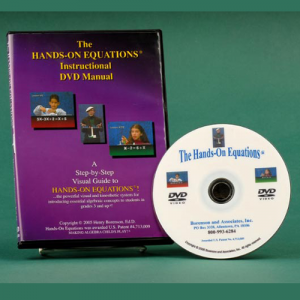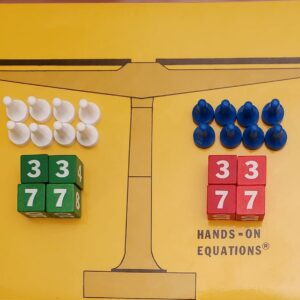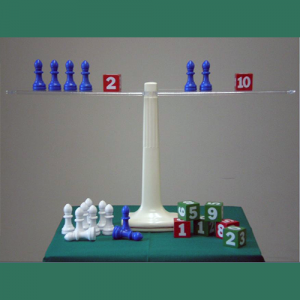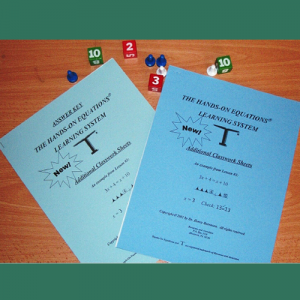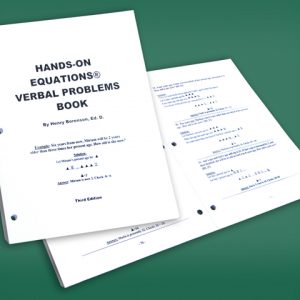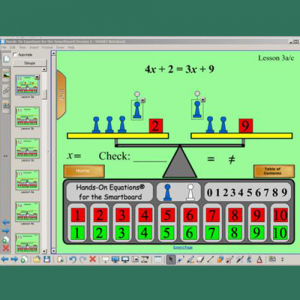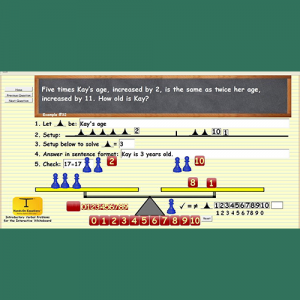Hands-On Equations® Teacher Materials
Making Algebra Child's Play® in grades 3 and up.

-
The Hands-On Equations Instructional DVD
$9.95 -
Sale!
The Hands-On Equations Learning System
Original price was: $44.95.$37.95Current price is: $37.95. -
Hands-On Equations Student Kit
$5.75 -
Sale!
 Select options This product has multiple variants. The options may be chosen on the product page
Select options This product has multiple variants. The options may be chosen on the product pageHands-On Equations Class Set
Price range: $157.00 through $307.00 -
Sale!
Teacher Demonstration Balance Scale and Game Pieces
Original price was: $96.00.$72.00Current price is: $72.00. -
Additional Classwork Sheets & Answer key
$25.00 -
Hands-On Equations Verbal Problems Introductory Workbook
$20.00 -
The Hands-On Equations Verbal Problems Book
$35.00 -
Verbal Problems Book Level I – Blackline Masters
$25.00 -
Hands-On Equations for the SMART Board
$25.00 -
Hands-On Equations Interactive for the Windows PC
$25.00 -
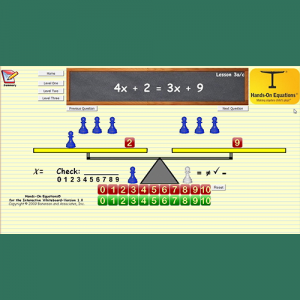 Select options This product has multiple variants. The options may be chosen on the product page
Select options This product has multiple variants. The options may be chosen on the product pageHands-On Equations for the Interactive Whiteboard
Price range: $25.00 through $100.00 -
Hands-On Equations Introductory Verbal Problems for the Interactive Whiteboard – Windows Download
$25.00
Support FAQ Hands-On Equations
All of our products come with a 30-day money-back guarantee. Hence, you may order an individual or class set, try it out, and if you are not satisfied that it achieves for you the claims that we make for the product, return it with a short explanation and we will refund the purchase price, less the shipping and handling charge. If you have any special needs, please send your inquiry to [email protected]
Please get in touch with our office at [email protected] for the procedure to get a complimentary replacement.
We have pre- and post-tests for Levels I, II, and III. They may be found here.
The classroom set for thirty students consists of the Teacher’s Demonstration Scale and Game Pieces, the Hands-On Equations Learning System, which has the teacher manuals for all three levels, the set of worksheets with reproduction rights, and the answer key. It also includes thirty sets of student kits (game pieces and flat laminated balance).
No, these are a new set of worksheets, one worksheet for each lesson, each one containing ten new equations.
The Hands-On Equations Learning System is the full program for working with one student at a time. It includes the teachers’ instructional manuals for all three levels, the set of class work sheets (without reproduction rights, except for home use), the answer key, and one set of student game pieces. Note: The Teachers’ Demonstration Scale and Game Pieces are not included in the individual set.
The Hands-On Equations Introductory Verbal Problems Introductory Workbook is for grades 3 – 6 students. It contains 80 verbal problems that can be solved using Level 1 of Hands-On Equations. The Hands-On Equations Verbal Problems Book is intended for middle and high school students. It contains more than 350 verbal problems covering all three levels of Hands-On Equations. Some of these problems will challenge your most advanced students!
Yes, we recommend students complete Level I of Hands-On Equations before moving on to Level I of Hands-On Equations Fractions. By working with Hands-On Equations first, they will gain a basic understanding of the meaning of an algebraic linear equation and the concept of a legal move.
If you have your own class set, we recommend using it once a week. This will provide the students with spaced reinforcement of the content. If you are borrowing a class set for a short period, we recommend completing one level in about 1 – 2 weeks.
The length of a Hands-On Equations lesson varies with the lesson and the student population and can take between 20 and 50 minutes, including the completion of the worksheet. The introductory component by the teacher, and two practice problems, might take 10-20 minutes; the time to complete the worksheet might take 10 to 30 minutes.
If your students have trouble solving simple equations such as 4x + 3 = 3x + 9 or 2(2x + 1) = 3x + 10, then this program will be of value to them. You will be able to teach these equations and related concepts in the first seven lessons of the program. Your students will then have a good understanding of the symbolic notation, the notion of equivalence, and the subtraction property of equality. This will serve as a foundation for their other work in algebra.
Lesson 7 of Hands-On Equations introduces students to a pictorial notation they can use to solve the equations. Hence, they are no longer dependent on the concrete materials to solve equations such as 4x + 3 = 3x + 9 or 2(2x + 4) = x + 14. Many students can also transfer their learning to a mental solution as noted here.
We recommend that you complete Level 1 of Hands-On Equations, including Lesson 7 which introduces the pictorial notation. After that, you may introduce the mental solution. For example in the equation 4x + 5 = 3x + 13, the students would visualize taking away 3x’s or three pawns from each side, as well as taking off a 5-value from the cubes on both sides. They now mentally see two pawns worth 8, so each pawn or x is 4. If you are working with students in the 5th grade or higher, you may introduce the abstract written solution once you complete Lesson 7. See Lesson 26 in the green manual for suggestions.
We are happy to hear that you are providing Hands-On Equations to your lower achieving middle school students. Very often, such students are not given an opportunity to work with algebra. Your students seem to be fine with the conceptual learning: the meaning of the symbolic notation, the mapping of the equation onto the scale, and the legal moves. Their difficulty is with the arithmetic in doing the check. Some teachers have reported providing their students with calculators and showing them how to use them to do the calculations. Another approach, is to use number facts they already know. For example, most students know how to count by 5’s and 10’s. Let’s say they need to figure out the value of five pawns if each one has the value of 7. In that case, the students can first assume the pawn is worth 5, so they get 25. They can then add 2 for each pawn (since each pawn is worth 7 and not 5), to get 35. The same approach would work using 10 as a base for counting, as illustrated below.
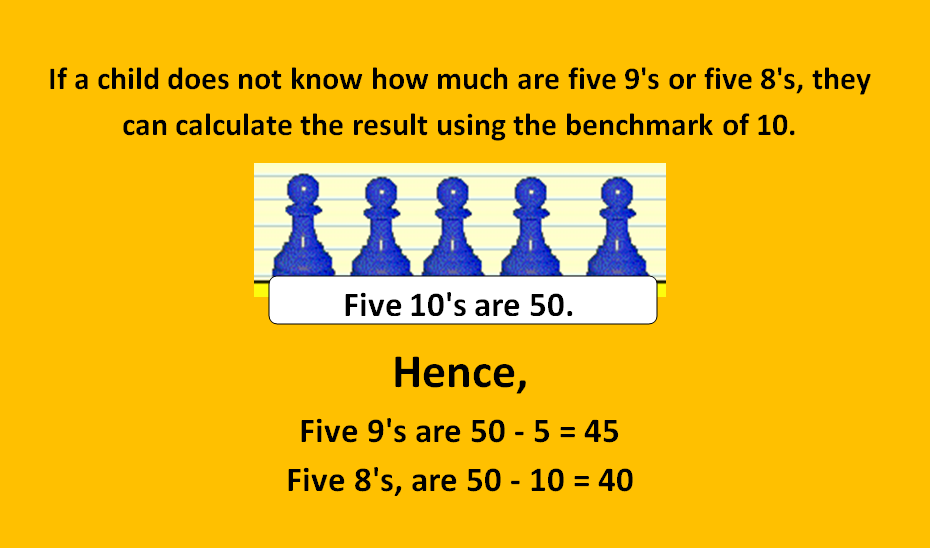
In Hands-On Equations, red numbered cubes represent positive numbers. When the program was first developed in 1986, the only numbered cubes commercially available were colored red. Hence, that color was chosen for the positive numbers. Although red was chosen out of necessity, the selection is a good one for the following reasons: 1) For young children in grades 3 – 5 red is a more attractive color than green and is a warmer color for beginning the program; 2) there are many instances were red is positive. For example, in a mercury thermometer, the more red the higher the temperature. The sun is red and is very hot. In weather chart, red is warm and green is cold. In electricity, the positive terminal is red.
The main reason why one might desire that red numbered cubes should represent negative numbers is that in accounting a red entry represents a loss. However, this reason should not overpower those mentioned above. Students very readily accept that the numbers on the red cubes, other than zero, represent positive numbers. We strongly encourage the teacher to work with the program as designed and work with the red cubes as positive. Doing so will be less confusing for the teacher, and it will be easier for the students to continue with the program in the next grade.
The Hands-On Equations program is intended to provide students in Grades 3 and up with a solid foundation for linear equations. In six lessons they learn to solve equations such a 4x + 3 = 3x + 9 and 2(2x + 1) = 3x + 12. Other important objectives are enhancing student interest in mathematics and self-perception and confidence in mathematics.
The worksheet reproduction rights follow the class set. Hence, if several teachers use the same class set, each teacher may reproduce the worksheet needed for their lesson.


